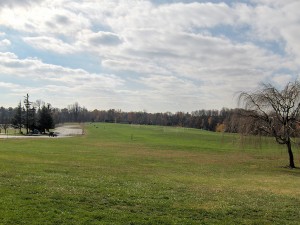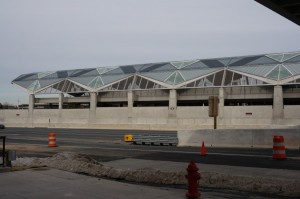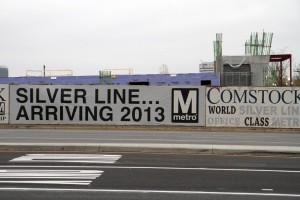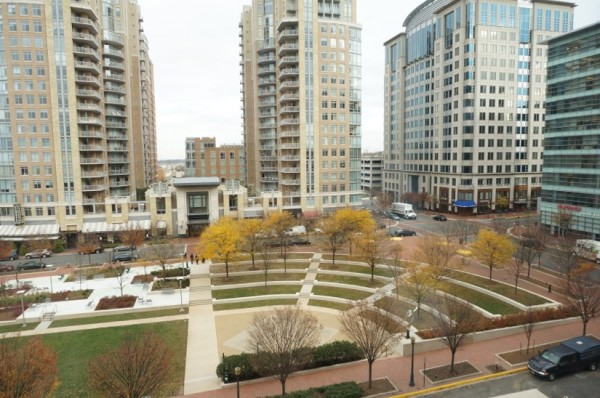 Last week, the Fairfax County Park Authority staff held a public meeting at which they laid out the draft Baron Cameron Master Plan, a plan that will guide development of the park for the next decade. It was followed by people, some representing local special interest groups, standing and saying what they wanted (or didn’t want) in the plan. The presentation opened a 30-day public comment period on the draft plan.
Last week, the Fairfax County Park Authority staff held a public meeting at which they laid out the draft Baron Cameron Master Plan, a plan that will guide development of the park for the next decade. It was followed by people, some representing local special interest groups, standing and saying what they wanted (or didn’t want) in the plan. The presentation opened a 30-day public comment period on the draft plan.
But there was no discussion about the plan, no collaborative thinking or problem solving on how Restonians as a community would propose to improve the plan.
Monday evening, all Restonians will have that opportunity at an interactive forum sponsored by RCA’s Reston 2020 Committee. The forum will be held at Buzz Aldrin Elementary School from 7 to 9 p.m.
Reston 2020 will begin by summarizing key aspects of the draft Baron Cameron Park plan. His presentation will focus on the most controversial aspects of the plan: the off-leash dog park, the option to build a recreation center there, the reduction in rectangular playing fields, and the implications for traffic congestion on Wiehle.
The forum will then break up into small groups to brainstorm community thinking about the plan, focusing on its strengths, weaknesses, what’s missing, and what the risks are in the plan. After each group briefly presents its ideas to the re-convened group, everyone will have a chance to help prioritize them. Then, in an open conversation, we will try to arrive at a consensus as to the most important points to make about the plan.
Reston 2020 will follow up by compiling the results and sharing them with the Park Authority as a consolidated community perspective, including listing all the ideas that came out of the small groups, before the end of the 30-day comment period.
The forum aims to provide an abundant opportunity to discuss all the key issues, not just advocate a single-issue position, and reach some community solutions to controversial aspects of the park plan.
This is the community’s last opportunity to provide a Reston perspective on the draft plan. Everyone is encouraged to come to the forum and participate in making Reston’s only district park the best it can be.
Terry Maynard
Co-Chair, Reston 2020
 Dulles Transit Partners, the contractor building Metro’s Silver Line Phase 1, is working to complete the rail extension by early April or face substantial fines.
Dulles Transit Partners, the contractor building Metro’s Silver Line Phase 1, is working to complete the rail extension by early April or face substantial fines.
Reston 2020 co-chair Terry Maynard has an idea of what to do with those fines — put them toward alleviating the burden on Dulles Toll Road users, who face mounting costs that will help pay for Silver Line Phase 2.
“I believe that every last cent of those fines should go to stabilizing DTR tolls,” Maynard recently wrote in a letter to Rep. Gerry Connolly (D-11th). “Although the projected sums of the fines are not large compared with the multi-billion dollar price tag of Phase 1 of the line’s construction, we are at the point where every dollar counts.”
DTR told the Metropolitan Washington Airports Authority (MWAA) Feb. 7 that it had “reached substantial completion” on the rail extension, which will run from East Falls Church to Reston’s Wiehle Avenue. However, after a two-week review period, MWAA found issues with 7 of 12 areas, ranging from leaks to problems with the automatic train control system.
The contractor is currently fixing the issues. Then there will be another review period. If the work passes, the project will be turned over to Metro, which has 90 days to complete its own testing before opening the long-awaited Silver Line.
However, The Washington Post reported that DTP’s contract states the contractor must finish the work within seven months of the agreed upon completion date of Sept. 9, 2013 — or face fines in the millions.If the work is not finished within that time, starting roughly April 10, DTP would face a $25,000-a-day penalty until the work is done. If the project is not completed 92 days after that April date, the contractor would have to pay roughly $2.3 million in fines, plus an additional $75,000 a day.
Ultimately, if the project is delayed more than six months from that April date, DTP could be required to pay more than $9 million total. Under the terms of the contract, the payments are capped at $60 million.
Meanwhile, tolls on the toll road may rise substantially to help build Silver Line’s Phase 2, which will run from from Wiehle Avenue to Dulles International Airport and into Loudoun County. The $2.7 billion Phase 2 is being built without federal funding, though it is now expected to get federal TIFIA loans, which are expected to keep tolls at a more reasonable level.
Early last year, MWAA said that toll rates may be as high as $6.75 by 2018 in order to keep pace with Silver Line costs. Independent estimates say the tolls could rise even higher.
“My greatest fear is that fines paid to MWAA will not be used in a manner that advances the Silver Line, much less eases the financial burden on DTR users,” Maynard said in his letter to Connolly. “I also do not think that the ‘funding partners’ allocation of these funds is an equitable or fair way to handle any forthcoming fine revenue.
“As you know well, DTR users are now stuck with about half of the cost of Phase 1 of the Silver Line under the “funding partners” agreement — and most of them won’t be able to use the Silver Line to get to their destinations. Assuring that any fine revenue is directed at easing their growing toll burden would be one small step toward correcting this inequitable arrangement.”
The full text of the letter is below:
Dear Congressman Connolly,
As a Restonian and fellow advocate of the Silver Line, I would like to ask you—as a leader in advancing the Silver Line’s completion—to pursue further financial assistance in alleviating the terrible toll increase burden Dulles Toll Road users are paying for its construction. It appears that an opening is available: If, as reported by the Washington Post, Dulles Transit Partners (DTP) faces substantial fines for further delays in completing the line, I believe that every last cent of those fines should go to stabilizing DTR tolls. Although the projected sums of the fines are not large compared with the multi-billion dollar price tag of Phase 1 of the line’s construction, we are at the point where every dollar counts.
My greatest fear is that fines paid to MWAA will not be used in a manner that advances the Silver Line, much less eases the financial burden on DTR users. I also do not think that the “funding partners” allocation of these funds is an equitable or fair way to handle any forthcoming fine revenue. As you know well, DTR users are now stuck with about half of the cost of Phase 1 of the Silver Line under the “funding partners” agreement—and most of them won’t be able to use the Silver Line to get to their destinations. Assuring that any fine revenue is directed at easing their growing toll burden would be one small step toward correcting this inequitable arrangement.
I hope that you can make sure that the $30 million or so in fines that the Post suggests may be forthcoming will be directly applied to the share of the construction cost borne by DTR users.
In the meantime, thank you for all that you have done to advance the Silver Line’s construction. I certainly hope that its completion is near at hand and we can begin riding the rails soon.
Sincerely,
Terry Maynard
Board of Directors, Reston Citizen Association
Co-Chair, RCA Reston 2020 Committee
One of the major criticisms from Reston development-watchers about the changes to the Reston Master Plan is the lack of planning for recreational and athletic space if Reston experiences a projected population boom of 30,000-40,000 in coming years.
As the Fairfax County Board of Supervisors gets ready for its Tuesday meeting, where it is expected to vote on changes to the comprehensive plan, advocacy group Reston 2020 took a look at how Reston of the future stacks up with the most urban of all transit-oriented developments: Manhattan.
“The draft Reston transit station area master plan promises less than two-thirds the playing fields per capita for the totality of the station areas and less than half for the “crown jewel” of Reston—Reston Town Center,” writes co-chair Terry Maynard. “This focused picture is just part of the rather pathetic comparison of Reston’s proposed park space compared with what already exists in Manhattan.”
A little background:
The Reston Master Plan Special Study Task Force spent four years trying to find the right formula for future development. The group’s final draft originally called for 12 additional athletic field to be added in Reston based on projected population growth of about 44,000.
But the final version that passed the county planning commission last month asks for at a minimum, three fields to be built — one near each of the transit stations at Wiehle-Reston East, Reston Parkway and Herndon-Monroe.
“The draft Reston plan calls for a minimum of three athletic fields in each of the three station areas and, in fact, goes further by saying at least one in each station area,” says Maynard. “This despite the fact that the County’s “urban parks framework” calls for a dozen athletic fields given the planned for population of 49,118 two or three decades hence, which is about one-third the athletic field standard for the County’s suburban areas.
“The reality of this “minimum” requirement is that it is highly unlikely that developers will give up any additional acreage (up to 3 acres per field, which could generate some $12 million per year total added developer revenues in today’s market as Class “A” office space) to accommodate the County urban standard of 12 ballfields.”
Maynard found that Reston’s formula means that Reston will have a park accessibility score that is 1/30th that of Manhattan.
Read the full report on Reston 2020’s website.
More:
 The draft master plan for Reston’s share of the Dulles Corridor and the Town Center area will be the subject of a public hearing by the Board of Supervisors next Tuesday, Jan. 28, 4:30 p.m., in the Government Center auditorium. It will be the last chance for Restonians to present its concerns, views, and suggestions on the draft plan before the Board considers amendments and approves the draft plan.
The draft master plan for Reston’s share of the Dulles Corridor and the Town Center area will be the subject of a public hearing by the Board of Supervisors next Tuesday, Jan. 28, 4:30 p.m., in the Government Center auditorium. It will be the last chance for Restonians to present its concerns, views, and suggestions on the draft plan before the Board considers amendments and approves the draft plan.
As it stands now, the draft plan overwhelmingly represents the views of developers and land use attorneys who numerically dominated the task force. Reston’s leading civic groups—RA, RCA, and ARCH—and a few other independent Restonian members of the task force have been active voices over the last four years, but their voices and votes have been drowned by the special interests of the majority developers, landowners, and attorneys. Their view is that the plan should stay out of the way as exemplified by the dozens of references to “flexibility” throughout the draft plan, attempts to limit commitments to open space, sustainable development, architectural review, controlling traffic congestion growth, and commercial vs. housing balance commitments throughout the process.
They are also dominating the preparation of the task force’s report to the Board of Supervisors. The draft task force report attempts to weaken further the language of the draft plan as it has been presented to the Board. RCA has taken the time to thoroughly review and comment on the draft task force report’s shortcomings including many more than described above. Ultimately, RCA voted “nay” on the draft task force report.
Even the Planning Commission has amended the draft Plan on its way to the Board by cutting out a proposed requirement that new construction be reviewed by RA’s Design Review Board. The likely result: A developer-dominated design review board (if any) that won’t care about architectural excellence—a key Reston planning principle. For example, see the results around Wiehle and Sunset Hills from the previous RCIG Architectural Review Board (ARB). Would you like to see a high-rise version of that asphalt and concrete mess?
The situation has not been helped by the fact that County property tax revenue coffers have been stagnant for years, and the Board has been criticized by national bond rating agencies (“outlook negative”) for its overspending in a tighter economic environment as Federal tax dollars for employees and contractors has declined with the recession, sequestration, and irresponsible government shutdowns. All of this has led the Board to focus on generating more taxable property growth in its urbanizing areas—Tysons, Reston, Springfield, and others—no matter what the community costs. That is a far easier course of action for the Board than cutting budgets or increasing tax rates.
RCA’s Reston 2020 Committee has written extensively about the issues and opportunities a new Reston master plan needs to address. It has produced more than a dozen major papers, many approved by the RCA Board of Directors, available from links on its website detailing these issues and opportunities. As the task force process began steamrolling toward its conclusion last autumn, RCA’s representative called up on the task force to produce a draft plan that befit this planned community. It has not.
It is now up to you, Reston residents, to make your voice heard unless you want to see a Dulles Corridor that:
- Reminds you of Crystal City in its property line to property line, concrete and glass, cubist architecture;
- Makes it virtually impossible to drive from one side of Reston to the other—or even to/from the toll road—during rush hours with 5-6 minute delays at each key intersection the norm;
- Guarantees next-to-no new open and recreational space, including only three athletic fields for the area’s expected 40,000 new residents; and
- Fails absolutely in describing how any of its plans might be implemented;
- And other shortcomings as detailed in RCA’s Reston Master Plan Report Card.
I would ask that you each consider whether it is worth your time to attend the hearing next Tuesday to hear what your community representatives (and developers) have to say and, if you are willing, to present a short statement (three minutes is the limit) to the Board about your concerns and ideas for building a better urban Reston area. To sign up to speak at the hearing, please go to this webpage on the County website.
It is our community’s last chance to make a difference in a plan that will guide the urbanization of Reston’s core for two or more decades. We need your help. Please attend next week’s hearing and testify if you are willing.
Terry Maynard
RCA Board of Directors
RCA Representative to the Reston Task Force
Co-Chair, RCA Reston 2020 Committee
Where people will live and work in the Reston of the future has been spelled out in changes to the Reston Master Plan, which the Fairfax County Board of Supervisors will discuss on Jan. 28.
But where will they play?
Athletic fields have continued to be a sore spot for development watchers. Reston 2020, for instance, says that with tens of thousands of additional residents likely to move into high-density areas around Reston’s three transit stations there will also be an increased need for more athletic fields.
There already is an existing field deficit, the master plan points out, especially in the area lining the Dulles Toll Road, which was formerly designated as commercial only. Growth and development planned for that area, as well as in the one-quarter mile area closest to the transit stations, “will exacerbate the existing deficits,” the Master Plan draft amendment says.
The draft formulated by the Reston Master Plan Special Study Task Force originally called for 12 additional athletic field to be added in Reston based on projected population growth of about 44,000. The final version that passed the county planning commission last week asks for at a minimum, three fields to be built — one near each of the transit stations.
“The provision of new athletic fields that require larger land areas within Reston TSAs (Transit Station Areas) is especially important and challenging,” the report states. “Creative approaches to providing for sports needs in Reston will be necessary, including integrating facilities within development areas, on rooftops, over stormwater detention facilities, in utility corridors and other alternative locations.”
The opening of Metro’s Silver Line will transform the Tysons Corner and Reston areas into transit-oriented edge cities in the decades to come, says a report from real estate services firm Cushman & Wakefield.
The report, “The Silver Line: Envisioning a New Tysons Corner” explores the Silver Line’s impact on the demographics, development and the overall real estate market. While it mainly concentrates on Tysons Corner, the Reston is expected to see a similar transformation.
“It’s an exciting time to be in Tysons – while the transformation of a suburban, automobile-centric office market into a more urban, walkable ‘urban’ center will take some time, it will happen,” said Paula Munger, C&W’s research managing director in the Mid-Atlantic and Southeast. “The trend towards 24/7 live-work-play environments is playing out in office markets globally, and the Silver Line will stimulate it in our region.”
Phase I of the $3.2 billion Silver Line will run from East Falls Church to Reston’s Wiehle Avenue. While originally estimated to open this month, there have been several testing delays and the project will open sometime in early 2014. Metro officials have not given a firm date. Phase 2 will run from Wiehle-Reston East to Dulles International Airport and into Ashburn. Phase 2 stations are not yet under construction will not open until at least 2018.
Cushman & Wakefield says the opening of Northern Virginia’s first new Metro stations in more than 15 years will make Tysons — and in essence Reston — a more attractive place for Washington’s workforce, who can now more easily commute (or reverse-commute) from Washington, D.C., or Arlington.
The report uses the Rosslyn-Ballston area of Arlington as a hint of what might be to come.
Prior to the Metro’s arrival in Arlington in 1977, the R-B Corridor had 26 office buildings with more than 25,000 square feet; a total of just over 4.1 million square feet of space. Today, the Corridor boasts 101 properties totaling 20.2 million square feet.
The R-B Corridor also experienced a significant boom in residential housing units after the introduction of the Metro. Prior to the Metro’s opening, the entire RB Corridor contained 23 multi-family projects with over 100 units. Combined, these developments totaled about 6,000 units. Today, there are 74 such projects totaling just under 200,000 units.
That’s what groups like Reston Citizens Association’s Reston 2020 are envisioning too. But where commercial real estate firms see a gold rush, Reston 2020 sees frustrated residents and traffic jams. The group estimates the Wiehle station alone will bring 13,000 additional jobs and 5,500 new residential households by 2030-2040, causing clogged streets unless some big changes are made.
Reston 2020 recently gave the proposed changes to the Reston Master Plan — which will be voted on by the Fairfax County Planning Commission in January — an overall letter grade of D when it comes to planning for the changes in population and workers.
Meanwhile, Cushman & Wakefield says that despite an overall slowdown in investment sales for Northern Virginia, the Silver Line expansion has drawn high notice from investors. Since 2010, $1.2 billion in investor office transactions have been in the vicinity of Phase I stations.
The report also says that investors recognize he future population increase’s effect on high-end multifamily apartments.
“The proposed apartments should be able to command top dollar as a result of their proximity to the stations, retail centers, luxury amenities and the overall higher income of the area,” the report says. “This may spur investors to upgrade recently purchased properties to match the offerings of future new construction.”
One of those new buildings, The Avant at Reston Town Center, which will be in walking distance to the Phase 2 Reston Parkway Silver Line station, recently opened with high-end amenities and high-end prices. Rents for a one bedroom start at more than $2,000 a month.
 The Reston Master Plan Task Force is about to publish what could be its final draft for the future of development around Reston’s Metro stations, and the Reston 2020 Committee is giving those plans a ‘D’ grade.
The Reston Master Plan Task Force is about to publish what could be its final draft for the future of development around Reston’s Metro stations, and the Reston 2020 Committee is giving those plans a ‘D’ grade.
Reston 2020, the community planning entity of the Reston Citizens Association, presented the findings to RCA at its regular meeting on Monday.
Reston 2020 co-chair Terry Maynard says the group examined each section of the draft Plan in terms of its impact on Reston’s quality of life and the community’s vision and values.
“The overall grade was based on the compilation of grades for each of the draft Plan’s sections,” Reston2020 said in a press release. “The highest grade given, a “B”, was awarded to the Overview, which covers Reston’s Vision and Planning Principles, and to the Environmental Stewardship section. Grades of “F” — which meant the section met virtually none of Reston’s expectations—were earned by the Urban Parks, Recreation, and Cultural Facilities section and the Implementation section.
“We’ve worked as hard on this as anyone over the last 4 years,” said RCA President Colin Mills. “I’d hoped that by now, we’d have something we could all be proud of. But we’ve got to call it like we see it, and there are major issues that haven’t been addressed yet. We need a plan that meets our community’s expectations for the future.”
Said Maynard: “Restonians deserve a draft Plan that is much more responsive to their needs now and in the future. This draft Plan generally focuses on the needs of developers and the County although we appreciate its relative strength in environmental stewardship, an important concern to Restonians.”
The RCA Board voted unanimously to direct Maynard, RCA’s representative to the Special Study Task Force, to vote “No” on the draft plan in its current form if a vote is taken as planned at the task force’s meeting Tuesday.



